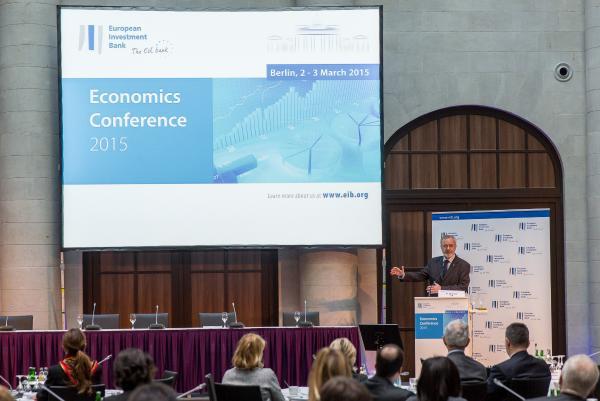
Declining productivity growth is undermining Europe’s ability to compete in the global marketplace. This was the message of economic experts and policy makers as they debated the current state of Europe’s economy. A high level conference by the Economics Department of the European Investment Bank (EIB) held in Berlin today discussed recent political and macro-economic efforts to restore competitiveness in Europe and respond to structural investment needs.
In his opening speech, EIB President Werner Hoyer called for a concerted effort to create an environment where investment and innovation naturally take place: “This means a combination of structural reforms in member states, efforts to complete the EU internal market where needed and a well targeted investment stimulus which addresses long term competitiveness challenges.” Hoyer also pointed to the shifting global environment for competition: “In a globalized world, it is really firms that compete, not countries. It is at the firm level that the all-important innovation process mostly takes place. But this does not mean that policy makers and public institutions can just wash their hands and hope for the best. We have a vital role to play, creating the right conditions and the right incentives to foster a dynamic process of innovation.”
The ensuing expert panels discussed how the economic crisis was aggravated by structural weaknesses and how high uncertainty, weak demand, and low investor confidence has hampered overall investment. With Europe’s banks facing constraints impeding their ability to absorb further risk, it was argued that ample liquidity in the system is not translating into the right kind of risk financing instruments. Yet to be able to compete in an increasingly open world, a dynamic and technologically innovative economy is critical.
“Fiscal, monetary and structural policies are synergistic,” said Catherine Mann, Chief Economist of the OECD. “We can’t just strip out structural and say, do this, do that, and ignore what’s happening on the demand management side. In order for structural reforms to get traction, you need to have a strong demand environment.” She asked how the investment plan for Europe or Juncker plan could help address these challenges. “What we find is that the multipliers for collective spending are greater than those for individual national projects. So collective action matters. Second, we find that regulatory harmonisation could increase cross-border FDI and trade intensity in Europe by up to 25%. So the potential pay-off to completing the single market is very large.”
EIB Chief Economist Debora Revoltella argued that a well-targeted investment stimulus, such as the investment plan for Europe, could help address short term cyclical issues while targeting long-term competitiveness challenges: “This is a case of investment action that targets strategic investment needs, including research and development, education, and infrastructure that enhances competitiveness. This kind of investment, if publicly incentivised, needs to be transparently managed. It has to target market failures without undermining competition.”
The conference launched the annual EIB report “Investment and investment finance in Europe – 2015” that examines the investment trends and challenges facing Europe (http://www.eib.org/infocentre/publications/all/investment-and-investment-finance-in-europe-2015.htm).A recent EIB study on competitiveness reveals the extent of investment gaps and how much catching up has to be done. (http://www.eib.org/infocentre/publications/all/restoring-eu-competitiveness.htm)

Photographer: EIB ©To be defined
Download original

Photographer: EIB ©To be defined
Download original

Photographer: EIB ©To be defined
Download original

Photographer: EIB ©To be defined
Download original

Photographer: EIB ©To be defined
Download original

Photographer: EIB ©To be defined
Download original

Photographer: EIB ©To be defined
Download original